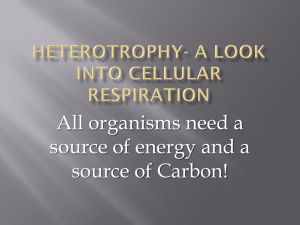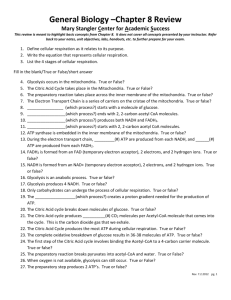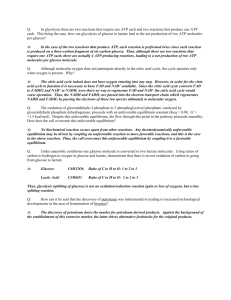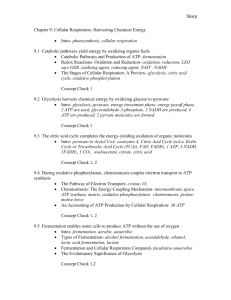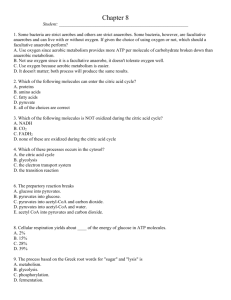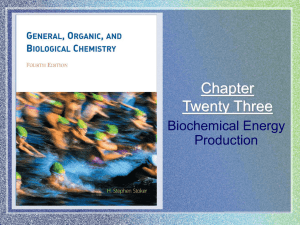Rebel Biology - ATP and Aerobic Respiration Take Home 1.___
advertisement
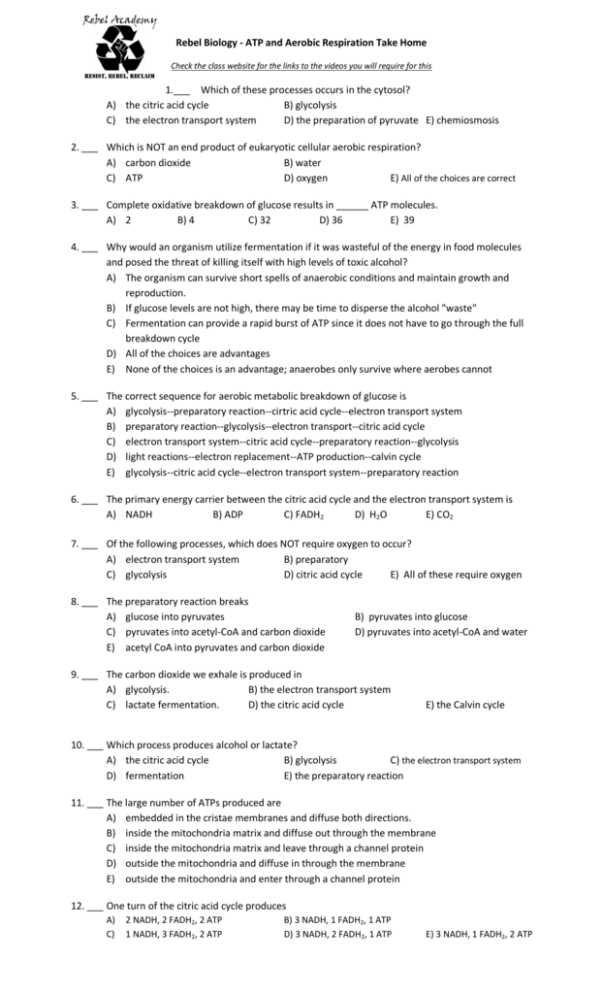
Rebel Biology - ATP and Aerobic Respiration Take Home Check the class website for the links to the videos you will require for this 1.___ Which of these processes occurs in the cytosol? A) the citric acid cycle B) glycolysis C) the electron transport system D) the preparation of pyruvate E) chemiosmosis 2. ___ Which is NOT an end product of eukaryotic cellular aerobic respiration? A) carbon dioxide B) water C) ATP D) oxygen E) All of the choices are correct 3. ___ Complete oxidative breakdown of glucose results in ______ ATP molecules. A) 2 B) 4 C) 32 D) 36 E) 39 4. ___ Why would an organism utilize fermentation if it was wasteful of the energy in food molecules and posed the threat of killing itself with high levels of toxic alcohol? A) The organism can survive short spells of anaerobic conditions and maintain growth and reproduction. B) If glucose levels are not high, there may be time to disperse the alcohol "waste" C) Fermentation can provide a rapid burst of ATP since it does not have to go through the full breakdown cycle D) All of the choices are advantages E) None of the choices is an advantage; anaerobes only survive where aerobes cannot 5. ___ The correct sequence for aerobic metabolic breakdown of glucose is A) glycolysis--preparatory reaction--cirtric acid cycle--electron transport system B) preparatory reaction--glycolysis--electron transport--citric acid cycle C) electron transport system--citric acid cycle--preparatory reaction--glycolysis D) light reactions--electron replacement--ATP production--calvin cycle E) glycolysis--citric acid cycle--electron transport system--preparatory reaction 6. ___ The primary energy carrier between the citric acid cycle and the electron transport system is A) NADH B) ADP C) FADH2 D) H2O E) CO2 7. ___ Of the following processes, which does NOT require oxygen to occur? A) electron transport system B) preparatory C) glycolysis D) citric acid cycle E) All of these require oxygen 8. ___ The preparatory reaction breaks A) glucose into pyruvates C) pyruvates into acetyl-CoA and carbon dioxide E) acetyl CoA into pyruvates and carbon dioxide B) pyruvates into glucose D) pyruvates into acetyl-CoA and water 9. ___ The carbon dioxide we exhale is produced in A) glycolysis. B) the electron transport system C) lactate fermentation. D) the citric acid cycle E) the Calvin cycle 10. ___ Which process produces alcohol or lactate? A) the citric acid cycle B) glycolysis C) the electron transport system D) fermentation E) the preparatory reaction 11. ___ The large number of ATPs produced are A) embedded in the cristae membranes and diffuse both directions. B) inside the mitochondria matrix and diffuse out through the membrane C) inside the mitochondria matrix and leave through a channel protein D) outside the mitochondria and diffuse in through the membrane E) outside the mitochondria and enter through a channel protein 12. ___ One turn of the citric acid cycle produces A) C) 2 NADH, 2 FADH2, 2 ATP 1 NADH, 3 FADH2, 2 ATP B) 3 NADH, 1 FADH2, 1 ATP D) 3 NADH, 2 FADH2, 1 ATP E) 3 NADH, 1 FADH2, 2 ATP Rebel Biology - ATP and Aerobic Respiration Take Home Check the class website for the links to the videos you will require for this Use the following to answer questions 13: 13. ___ The first process in breaking down glucose is A) the citric acid cycle B) glycolysis C) the electron transport system D) fermentation E) the preparatory reaction Labelling: A) inter membrane space B) matrix C) envelope D) Cristae Answers: 1. B 2. D 3. D 4. A 5. A 6. 7. 8. 9. 10. A C C D D 11. 12. 13. C E B
